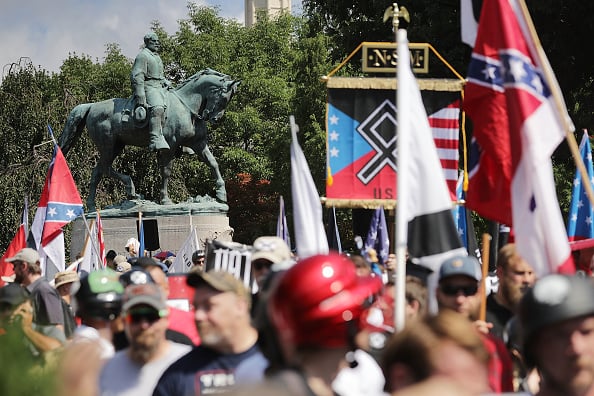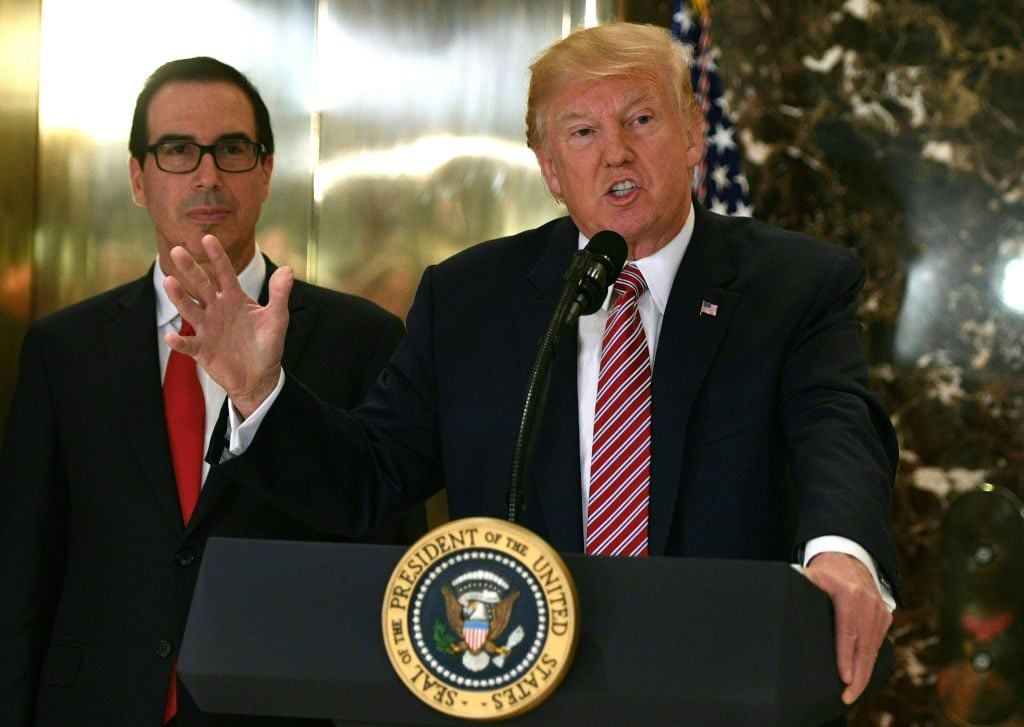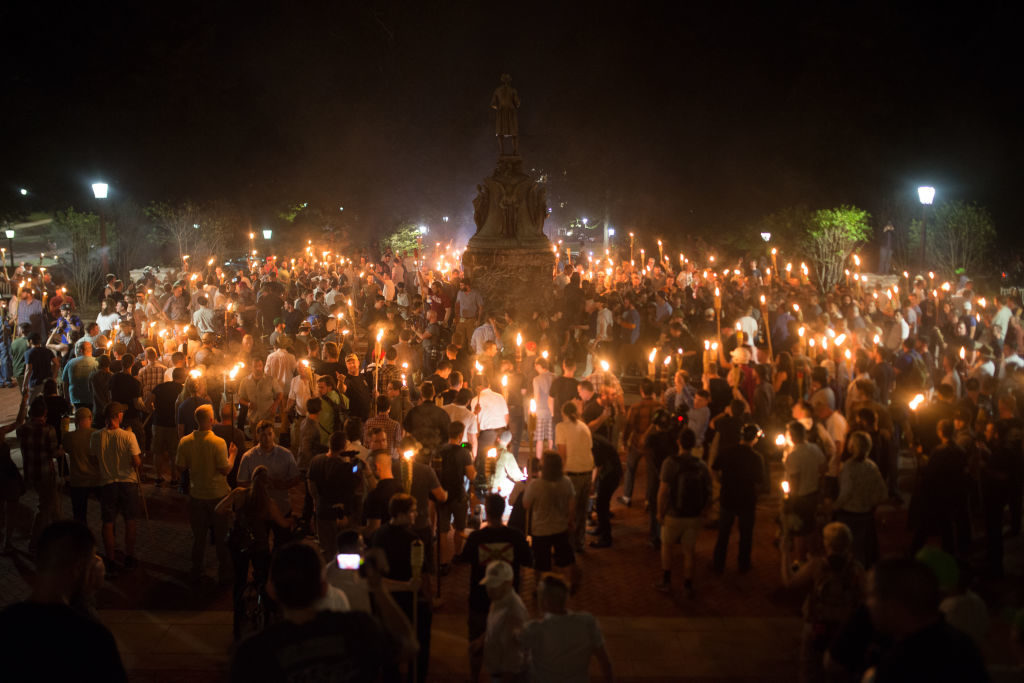Politics
Monumental Lies: Charlottesville’s Lee Statue Was Designed to Erase a History We Need to Remember
The mythology of Confederate monuments is "fake history," concocted with cynical ends.

The mythology of Confederate monuments is "fake history," concocted with cynical ends.

Ben Davis

You had some very bad people in that group. But you also had people that were very fine people on both sides…. I saw the same pictures as you did. You had people in that group that were there to protest the taking down, of to them, a very, very important statue and the renaming of a park from Robert E. Lee to another name.
Tuesday evening’s statement by the president was an appalling dodge, a nasty bit of self-serving obfuscation in an hour of heartbreak.
Perhaps the “very fine people” the president is referring to includes the twitchy, armed-to-the-teeth gentleman who told Vice News that the only thing he didn’t like about Trump was that he let his daughter marry a Jew?
I just want to say a quick word, however, about the historical meaning of that “very, very important statue,” and of Trump’s proposition that many “very fine people” came to the so-called “Unite the Right” rally in Charlottesville, Virginia merely to defend the symbols of a virtuous Southern heritage.
The president has very effectively appropriated the term “fake news” for his own ends. I hope, then, that I am not walking into a trap when I say that the important thing to stress about the contested monument to Robert E. Lee is that it represents “fake history.”
Moreover, its particular brand of fake history is engineered to do exactly what it is doing now.
Looking at just how helps to understand the particular bond between the wealthy populist and the feral throngs of white nationalists who descended upon Charlottesville last weekend.

US President Donald Trump speaks to the press about protests in Charlottesville after his statement on the infrastructure discussion in the lobby at Trump Tower in New York on August 15, 2017. Photo credit should read Jim Watson/AFP/Getty Images.
As Karen E. Fields and Barbara J. Fields emphasize in Racecraft, the “moonlight-and-magnolias” imagery, the cult of the heroic “Lost Cause of the Confederacy,” and the whole Confederate nostalgia industry in general was a product of the New South, not the Old. It was archaizing, but not archaic. “Only in the 1890s did the Confederacy become an emotional symbol,” they write.
Across the world, the late 19th century was epicenter for what historian Eric Hobsbawm termed “the invention of tradition.” Massive economic and social change in the era of unchained capitalism triggered a revival in various rituals that looked to the past, to give the semblance of continuity and wholeness to a rapidly changing world.
Post-Reconstruction Virginia, however, invented a form of rose-colored romanticism that had a particularly sinister cast.
The pioneering Association for the Preservation of Virginia Antiquities (APVA), founded in 1889, was the very first statewide historic preservation society in the United States, period.
The Southern society ladies who proselytized the late-19th century wave of Confederate museum, memorial, and monument building were very specifically out to create a new civic myth, a view of the past that could serve as a balm against the evils of the present as they saw it.
The Reconstruction Era (1865–77) had seen newly freed blacks participate in political life to an unprecedented and, in the minds of their former masters, unacceptable degree. The cause of Confederate preservation would aid in reconsolidating the prestige of traditional Southern elites. They sought, as James M. Lindgren wrote, “to win through monuments and pamphlets what Lee had lost at Appomattox.”
This new program, it is interesting to note, was not just a matter of reasserting an Antebellum racial hierarchy. It also reflected the demands of the contemporary class struggle.
Why was Virginia specifically ground zero of Confederate myth-making? After the fall of Reconstruction, in 1879, a new force known as the Readjuster Party had risen up among poor Virginians. The Readjusters united poor whites and poor blacks with a program based on funding public education and challenging finance capital, aiming “to break the power of wealth and established privilege”—meaning the power of the white commercial and planter elite.
That elite counterattacked (as they had during Reconstruction) by stoking racial resentment as a wedge to drive this coalition of have-nots apart. A bloody riot in majority-black Danville on the eve of the 1883 election, provoked by a confrontation between Democrats and Readjusters, was used to flood the state with propaganda about threats to order by black rule. The racist Democrats retook the state from the Readjusters.
Such was the political backdrop for the emphasis on the Lost Cause mythology that percolated in Richmond in the 1880s.
Venerating the humble white soldier for his loyalty to wise generals like Lee provided an alternative identification for lower-class men, used to pry them away from those pesky class animosities. As Reiko Hillyer writes, “If the faithful slave was central to the mythic past that justified the Jim Crow present, then the faithful Confederate soldier might encourage obedient behavior among the working classes of the New South.” (White women got the myth of the eternally chaste and loyal priestess of the homefront, when actual Southern women had often bitterly opposed the unequal impositions of the war.)
If Virginia’s brush with the Readjusters was the immediate background for the birth of the Confederate monuments boom, that movement’s spread across the South was set against another cross-race insurgency—one whose influence was so dramatic that its name has passed into the political lexicon.
This was the Populist movement. In its original 1890s sense, “populism” was powerfully left-wing—and its most radical arm was in the South.
The Southern poor were hard-hit by a fierce agricultural depression, ripped-off by rapacious railroads and monopolies in basic goods. “The left Populists formulated and won support for a program unique in Southern history before or since,” Jack Bloom writes in Race, Class, and the Civil Rights Movement. “They proposed to organize a political coalition around the growing similarity of the economic conditions facing both black and white farmers.”
Once again, the Southern political establishment responded with vote fraud, coercion, bribery, and violence against blacks. “The danger of ‘negro domination’ was raised once again,” Bloom writes, “and once again, note, it was by the upper-class whites.”
An intensified myth of Confederate identity provided the imaginary alternative to the menace of “negro domination.” The Southern Poverty Law Center has a useful timeline of Confederate monument construction. It is no coincidence that it dramatically spiked during the Populist period. (A second spike of Confederate veneration came in the 1960s, as a rejoinder to the civil rights movement.)
By 1912, the Confederate Veteran would boast that the movement “caused more monuments to be erected to the soldiers of the Confederate Army then have ever been erected in any age of the world to any cause, civil, political, or religious.”
For its part, Charlottesville’s 14-foot-tall bronze Lee was designed in 1924 by New York sculptor Henry Shrady, well after the defeat of Populism and the consolidation of official segregation with Jim Crow laws. It was unveiled as part of a conclave of the Sons of the Confederacy, an organization established in Richmond in 1896.
In a useful article, University of Virginia Ph.D. candidates Sophie Abramowitz, Eva Latterner, and Gillet Rosenblith trace how the spread of the various Confederate monuments that dot Charlottesville, including the contested Lee statue, has always been about more than commemoration of the past. Their placement has been part of cementing spatial domination over the city’s black community, marking the edges of public spaces in the process of being claimed for gentrification.

Neo-Nazis encircle counter protestors at the base of a statue of Thomas Jefferson after marching through the University of Virginia campus with torches in Charlottesville on August 11, 2017. Photo by Zach D Roberts/NurPhoto via Getty Images.
When President Trump pipes up for the “very fine people” unaccounted for within the weekend’s “Unite the Right” protests—those innocent Southern history buffs hidden among the torch-wielding white nationalists—he is dissembling.
But he is also just re-activating the historic function these monuments were constructed to perform in the first place: not to communicate a real past, but to concoct an image of white greatness romanticized and sanitized enough to provide a semblance of a popular base for unscrupulous white elites.
“The South Will Rise Again” shades easily over into “Make America Great Again.”
But the other half of the equation should not be forgotten either. This romance of the Confederacy, with its combination of fantasized glory and actual, thuggish violence, has always shadowed something else: the fear of movements that challenge both racism and class hierarchy.
In that sense, it is actually the multi-racial crowds of counter-protesters—at least one of whom gave her life standing for justice last weekend—who can claim the real heroic history in Charlottesville, the history that Robert E. Lee’s image was raised to suppress.